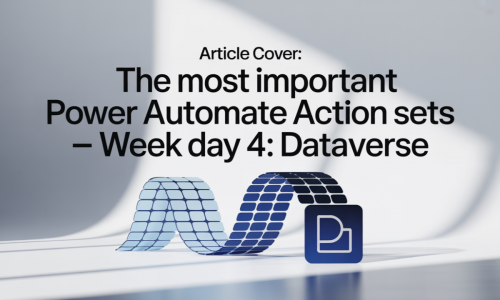Power Platform Bad Decision Week Day 6 – Documentation? Our Best Practice Is ‘Figure It Out Later’
-
Admin Content
-
Oct 03, 2025
-
237
When working with the Power Platform, we often find ourselves caught up in the excitement of building apps, flows, and solutions as quickly as possible. The thrill of automation, the joy of a successful formula, or the relief of seeing that approval flow finally work—it’s intoxicating. But then there’s that word no one likes to hear: documentation. And what’s our best practice for it? Well, naturally, “figure it out later.”
It’s a phrase that’s been whispered in countless project meetings, muttered under breaths in developer chats, and sometimes even proudly declared as a guiding principle. But what does it actually mean for teams, projects, and long-term success? Let’s unpack this.
The Allure of Skipping Documentation
When deadlines loom and stakeholders are eager to see results, documentation feels like the first thing to sacrifice. After all, why spend time writing out what you’re doing when you could just… keep building? It’s easy to justify skipping it with thoughts like “everyone will remember this,” or “the app is simple enough, no one will need instructions.”
The Power Platform’s low-code promise makes this temptation even stronger. Because so much can be built visually, with drag-and-drop connectors and simple expressions, it feels like the logic should speak for itself. Why would anyone need a diagram when they can just open the flow and look? Why waste time writing notes when the formulas are right there?
Unfortunately, this mindset assumes that your future self, or your colleagues, will always have the same context and clarity you do in the moment. Spoiler: they won’t.
The Future Self Dilemma
Picture this: six months from now, someone asks you to fix a bug in a flow you built. You open it up, scroll through the triggers, conditions, and actions, and realize you have absolutely no memory of why you added that third “Compose” action or why there’s a nested condition buried inside a loop. You promised yourself it was obvious at the time, but now it’s a riddle written in your own handwriting.
This is the cruel irony of documentation avoidance: you think you’re saving time, but what you’re really doing is shifting the cost forward. Your future self—or worse, your coworkers—are left trying to decode your “obvious” logic. That five minutes you didn’t spend writing a note turns into two hours of detective work.
Collaboration Without a Map
Documentation doesn’t just protect you from your own forgetfulness—it also makes collaboration possible. Without it, working together is like navigating a new city without street signs. Sure, you can eventually find your way around, but you’ll waste a lot of time making wrong turns.
When new team members join a project, or when someone outside your group needs to understand your solution, clear documentation becomes the bridge. It explains not just what you built, but why you built it that way. Skipping it means forcing others to reverse-engineer your thought process, which is not only inefficient but also frustrating.
Teams that embrace “figure it out later” often discover that “later” usually means “never.” And when “never” arrives, so does confusion, duplication of work, and the dreaded “can we just rebuild this from scratch?” moment.
Why We Still Say ‘Figure It Out Later’
If documentation is so obviously important, why does this anti-pattern persist? Partly because of the culture of speed. The Power Platform thrives on rapid development, proof-of-concepts, and MVPs. Stakeholders don’t cheer when you hand them a Visio diagram—they cheer when you show them a working app.
There’s also the misplaced belief that documentation has to be heavy and time-consuming, full of formal diagrams, long paragraphs, and painstaking formatting. In reality, even lightweight notes—naming conventions, short comments, a quick wiki page—can save hours of pain later. But because we equate “documentation” with “tedious,” it’s often pushed to the bottom of the to-do list.
A Better Way Forward
Here’s the twist: “figure it out later” can work—if you redefine what “later” means. Instead of “never,” what if “later” meant at natural checkpoints in the project? Right after finishing a flow, you take five minutes to jot down what it does and why. After publishing an app, you record a quick video walkthrough. These small, incremental efforts turn documentation from a burden into a habit.
The best practice isn’t to stop building and drown yourself in paperwork. It’s to weave documentation into the process so it feels less like a chore and more like a part of development hygiene. When you start treating it as essential as naming variables properly or testing before deploying, it becomes second nature.
Closing Thoughts
Power Platform Bad Decision Week is all about recognizing the shortcuts we take and laughing at the consequences. But behind the humor lies a serious truth: documentation is not optional if you want sustainable, scalable, and collaborative solutions. The joke of “figure it out later” only lands because so many of us have lived through its painful reality.
The next time you’re tempted to skip writing that note or ignore adding a comment, remember that you’re not just helping your future self—you’re helping your entire team succeed. Documentation doesn’t have to be perfect, but it does have to exist. Because “figure it out later” almost always turns into “wish we had figured it out sooner.”





